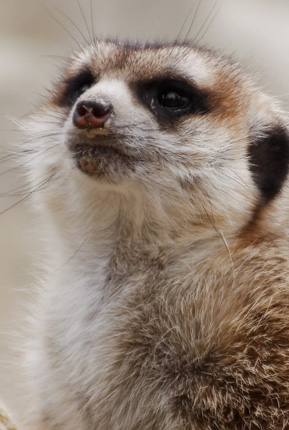
All Animals

The Meerkat: Social and Vigilant Inhabitants of the African Desert
The meerkat, a small but highly social member of the mongoose family, is one of the most intriguing animals of the African desert. Known for their upright stance, complex social structure, and remarkable adaptability, meerkats thrive in the harsh environments of the Kalahari Desert and other arid regions of southern Africa.
Meerkats are easily recognizable by their slender bodies, short legs, and long tails. Standing up on their hind legs to survey their surroundings, they have earned a reputation for their "watchful" posture. This behavior is crucial for their survival, as it allows them to spot potential predators and keep an eye out for danger while foraging for food.
One of the most striking features of meerkats is their highly social nature. They live in groups called mobs or clans, which can consist of up to 40 individuals. These social structures are characterized by cooperative behavior and intricate social dynamics. Within a mob, individuals work together to forage for food, care for the young, and protect each other from predators.
Meerkat mobs are organized with a clear hierarchy. Typically, a dominant pair, known as the alpha male and alpha female, leads the group. This pair is primarily responsible for breeding and producing offspring. The rest of the mob consists of subordinate individuals who assist with tasks such as babysitting, grooming, and foraging. This cooperative behavior enhances the survival of the group and ensures the well-being of all members.
Foraging is a vital activity for meerkats, as their diet consists mainly of insects, but they also consume small vertebrates, fruits, and plants. They use their sharp claws and agile movements to dig for food, often searching for underground insects and larvae. Their keen sense of smell helps them locate prey, and their agility allows them to quickly catch and consume it.
Meerkats are highly vigilant animals with a well-developed system of communication. They use a variety of vocalizations, including alarm calls, to alert the mob to the presence of predators. These calls vary in tone and intensity, depending on the type of threat. Meerkats also engage in non-vocal communication, such as grooming and scent marking, to reinforce social bonds and establish territory.
Despite their adaptability and social skills, meerkats face several challenges in the wild. Predation by larger animals, such as eagles, snakes, and hyenas, poses a constant threat. Additionally, environmental changes and habitat loss due to human activities can impact their survival. Conservation efforts are important to protect their natural habitats and ensure that meerkat populations remain stable.
Meerkats have also captured the public’s imagination and become popular in popular culture, appearing in documentaries, television shows, and even advertising. Their distinctive appearance and social behaviors make them engaging subjects for study and observation.
In summary, the meerkat, with its remarkable social structure, vigilance, and adaptability, is a fascinating inhabitant of the African desert. Its complex social dynamics and cooperative behavior underscore the importance of community and teamwork in the animal world. By supporting conservation efforts and fostering an appreciation for meerkats, we can help ensure the continued survival of this remarkable species and the preservation of their unique desert habitats.
